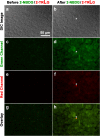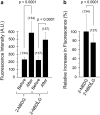Uptake of fluorescent D- and L-glucose analogues, 2-NBDG and 2-NBDLG, into human osteosarcoma U2OS cells in a phloretin-inhibitable manner
- PMID: 33454890
- PMCID: PMC7900340
- DOI: 10.1007/s13577-020-00483-y
Uptake of fluorescent D- and L-glucose analogues, 2-NBDG and 2-NBDLG, into human osteosarcoma U2OS cells in a phloretin-inhibitable manner
Abstract
Mammalian cells take in D-glucose as an essential fuel as well as a carbon source. In contrast, L-glucose, the mirror image isomer of D-glucose, has been considered merely as a non-transportable/non-metabolizable control for D-glucose. We have shown that 2-[N-(7-Nitrobenz-2-oxa-1,3-diazol-4-yl)amino]-2-deoxy-D-glucose (2-NBDG), a D-glucose analogue combining a fluorophore NBD at the C-2 position, is useful as a tracer for monitoring D-glucose uptake through glucose transporters (GLUTs) into mammalian cells. To more precisely evaluate the stereoselectivity of 2-NBDG uptake, we developed an L-glucose analogue 2-NBDLG, the mirror-image isomer of 2-NBDG. Interestingly, 2-NBDLG was taken up into mouse insulinoma MIN6 cells showing nuclear heterogeneity, a cytological feature of malignancy, while remaining MIN6 cells only exhibited a trace amount of 2-NBDLG uptake. The 2-NBDLG uptake into MIN6 cells was abolished by phloretin, but persisted under blockade of major mammalian glucose transporters. Unfortunately, however, no such uptake could be detected in other tumor cell lines. Here we demonstrate that human osteosarcoma U2OS cells take in 2-NBDLG in a phloretin-inhibitable manner. The uptake of 2-NBDG, and not that of 2-NBDLG, into U2OS cells was significantly inhibited by cytochalasin B, a potent GLUT inhibitor. Phloretin, but neither phlorizin, an inhibitor of sodium-glucose cotransporter (SGLT), nor a large amount of D/L-glucose, blocked the 2-NBDLG uptake. These results suggest that a phloretin-inhibitable, non-GLUT/non-SGLT, possibly non-transporter-mediated yet unidentified mechanism participates in the uptake of the fluorescent L-glucose analogue in two very different tumor cells, the mouse insulinoma and the human osteosarcoma cells.
Keywords: Imaging; L-glucose; Sarcoma; Transport; Tumor.
Conflict of interest statement
KY received grants above noted from Hirosaki University for developing potential cancer diagnostic agents, in which AS, KO, SO, YI are collaborators. KY, AS, and KO are co-applicants for multiple patents related to cancer diagnostics using fluorescent L-glucose derivatives. KY, AS, and KO assigned ownership of all these patents to Hirosaki University.
Figures





Similar articles
-
Uptake of a fluorescent L-glucose derivative 2-NBDLG into three-dimensionally accumulating insulinoma cells in a phloretin-sensitive manner.Hum Cell. 2016 Jan;29(1):37-45. doi: 10.1007/s13577-015-0125-3. Epub 2015 Nov 9. Hum Cell. 2016. PMID: 26553070 Free PMC article.
-
Aberrant Uptake of a Fluorescent L-Glucose Analogue (fLG) into Tumor Cells Expressing Malignant Phenotypes.Biol Pharm Bull. 2018;41(10):1508-1516. doi: 10.1248/bpb.b18-00089. Biol Pharm Bull. 2018. PMID: 30270319 Review.
-
A fluorescence method for measurement of glucose transport in kidney cells.Diabetes Technol Ther. 2011 Jul;13(7):743-51. doi: 10.1089/dia.2011.0041. Epub 2011 Apr 21. Diabetes Technol Ther. 2011. PMID: 21510766 Free PMC article.
-
Cellular binding and uptake of fluorescent glucose analogs 2-NBDG and 6-NBDG occurs independent of membrane glucose transporters.Biochimie. 2021 Nov;190:1-11. doi: 10.1016/j.biochi.2021.06.017. Epub 2021 Jul 2. Biochimie. 2021. PMID: 34224807 Free PMC article.
-
L-Glucose: Another Path to Cancer Cells.Cancers (Basel). 2020 Apr 1;12(4):850. doi: 10.3390/cancers12040850. Cancers (Basel). 2020. PMID: 32244695 Free PMC article. Review.
Cited by
-
The roles of glycolysis in osteosarcoma.Front Pharmacol. 2022 Aug 17;13:950886. doi: 10.3389/fphar.2022.950886. eCollection 2022. Front Pharmacol. 2022. PMID: 36059961 Free PMC article. Review.
-
Click Pt(IV)-Carbohydrates Pro-Drugs for Treatment of Osteosarcoma.Front Chem. 2021 Dec 7;9:795997. doi: 10.3389/fchem.2021.795997. eCollection 2021. Front Chem. 2021. PMID: 34950638 Free PMC article.
-
Differential Effect of Simulated Microgravity on the Cellular Uptake of Small Molecules.Pharmaceutics. 2024 Sep 14;16(9):1211. doi: 10.3390/pharmaceutics16091211. Pharmaceutics. 2024. PMID: 39339247 Free PMC article.
References
MeSH terms
Substances
LinkOut - more resources
Full Text Sources
Other Literature Sources
Medical
Miscellaneous

